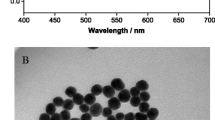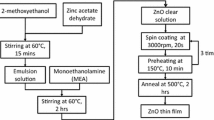Abstract
The focus of this study is the application of modified gold nanoparticles (AuNPs) for improvement of the analytical characteristics of DNA hybridization biosensors based on surface plasmon resonance (SPR) spectrometry. It was shown that the use of citrate-capped AuNPs in a biosensor assay leads to uncontrolled aggregation of AuNPs on the gold sensor surface, which is reflected in a significant increase in the SPR sensor response. This nonspecific sensor response significantly worsens the selectivity and specificity of detection of such a SPR biosensor. Therefore, in this study, 6-mercapto-1-hexanol and lipoic acid were used to modify the surface of AuNPs in order to improve their colloidal stability under chemical conditions facilitating DNA hybridization. The optimal concentration of these stabilizing molecules in order to minimize their aggregation on the gold plate of the SPR biosensor was determined. DNA biosensors functioning with the use of modified AuNPs were characterized by better sensitivity than that of a traditional DNA biosensor. As a result of this study, an optimal method of functionalizing AuNPs with oligonucleotides and stabilizing ligands was proposed for their further use to improve the analytical characteristics of DNA hybridization biosensors.









Similar content being viewed by others
References
Bulavin LA, Goncharenko NA, Dmytrenko OP, Pavlenko OL, Kulish MP, Goncharova O, Demydov PV, Lopatynskyi AM, Chegel VI (2019) Heteroassociation of antitumor agent doxorubicin with bovine serum albumin in the presence of gold nanoparticles. J Mol Liq 284:633–638. https://doi.org/10.1016/j.molliq.2019.04.017
Chegel V, Rachkov O, Lopatynskyi A, Ishihara S, Yanchuk I, Nemoto Y, Hill JP, Ariga K (2012) Gold nanoparticles aggregation: drastic effect of cooperative functionalities in a single molecular conjugate. J Phys Chem C 116(4):2683–2690. https://doi.org/10.1021/jp209251y
Dorozinsky G, Maslov V, Samoylov A, Ushenin Y (2013) Reducing measurement uncertainty of instruments based on the phenomenon of surface plasmon resonance. Am J Opt Photon 1(3):17–22. https://doi.org/10.11648/j.ajop.20130103.12
Ghosh SK, Pal T (2007) Interparticle coupling effect on the surface plasmon resonance of gold nanoparticles: from theory to applications. Chem Rev 107(11):4797–4862. https://doi.org/10.1021/cr0680282
Goncharenko NA, Pavlenko OL, Dmytrenko OP, Kulish MP, Lopatynskyi AM, Chegel VI (2019) Gold nanoparticles as a factor of influence on doxorubicin–bovine serum albumin complex. Appl Nanosci 9:825–833. https://doi.org/10.1007/s13204-018-0748-2
Goncharenko NA, Pavlenko OL, Dmytrenko OP, Kulish MP, Lopatynskyi AM, Goncharova OO, Tsegelna AV, Demydov PV, Chegel VI (2020) Understanding prodrugs: complexation in aqueous solutions of doxorubicin, bovine serum albumin and gold nanoparticles. Appl Nanosci 10:2941–2949. https://doi.org/10.1007/s13204-019-01060-y
Herne TM, Tarlov MJ (1997) Characterization of DNA probes immobilized on gold surfaces. J Am Chem Soc 119:8916–8920. https://doi.org/10.1021/ja9719586
Homola J (2008) Surface plasmon resonance sensors for detection of chemical and biological species. Chem Rev 108(2):462–493. https://doi.org/10.1021/cr068107d
Lang BE, Schwarz FP (2007) Thermodynamic dependence of DNA/DNA and DNA/RNA hybridization reactions on temperature and ionic strength. Biophys Chem 131(1–3):96–104. https://doi.org/10.1016/j.bpc.2007.09.007
Levicky R, Herne T, Tarlov M, Satija S (1998) Using self-assembly to control the structure of DNA monolayers on gold: a neutron reflectivity study. J Am Chem Soc 120(38):9787–9792. https://doi.org/10.1021/ja981897r
Liu B, Liu J (2017) Methods for preparing DNA-functionalized gold nanoparticles, a key reagent of bioanalytical chemistry. Anal Methods 9:2633–2643. https://doi.org/10.1039/C7AY00368D
Lugo TG, Pendergast AM, Muller AJ, Witte ON (1990) Tyrosine kinase activity and transformation potency of bcr-abl oncogene products. Science 247(4946):1079–1082. https://doi.org/10.1126/science.2408149
Markham NR, Zuker M (2005) DINAMelt web server for nucleic acid melting prediction. Nucl Acids Res 33(Web Server issue):W577–W581. https://doi.org/10.1093/nar/gki591
Matsishin M, Rachkov A, Losytskyy M, Soldatkin A (2014) Experimental approach using covalently attached fluorophore for quantification of oligonucleotide immobilization on gold nanoparticles. Colloid Interface Sci Commun 1:35–38. https://doi.org/10.1016/j.colcom.2014.06.009
Matsishin MJ, Ushenin IuV, Rachkov AE, Solatkin AP (2016) SPR detection and discrimination of the oligonucleotides related to the normal and the hybrid bcr-abl genes by two stringency control strategies. Nanoscale Res Lett 11(1):19. https://doi.org/10.1186/s11671-016-1226-y
Matsishin M, Rachkov A, Lopatynskyi A, Chegel V, Soldatkin A, El’skaya A (2017) Selective amplification of SPR biosensor signal for recognition of rpoB gene fragments by use of gold nanoparticles modified by thiolated DNA. Nanoscale Res Lett 12(1):252. https://doi.org/10.1186/s11671-017-2031-y
Merkoçi A (2010) Nanoparticles-based strategies for DNA, protein and cell sensors. Biosens Bioelectron 26(4):1164–1177. https://doi.org/10.1016/j.bios.2010.07.028
Rachkov A, Patskovsky S, Soldatkin A, Meunier M (2011) Surface plasmon resonance detection of oligonucleotide sequences of the rpoB genes of Mycobacterium tuberculosis. Talanta 85(4):2094–2099. https://doi.org/10.1016/j.talanta.2011.07.032
Rachkov A, Matsishin M, Chegel V, Lopatynskyi A, Yanchuk I, Soldatkin A (2014) Investigations of aggregation stability of gold nanoparticles at their interactions with compounds bearing thiol and/or amino functional groups. Chem Sens 4:16
Rich RL, Myszka DG (2008) Survey of the year 2007 commercial optical biosensor literature. J Mol Recognit 21(6):355–400. https://doi.org/10.1002/jmr.928
Rowley JD (1973) Letter: a new consistent chromosomal abnormality in chronic myelogenous leukaemia identified by quinacrine fluorescence and Giemsa staining. Nature 243(5405):290–293. https://doi.org/10.1038/243290a0
Sassolas A, Leca-Bouvier BD, Blum LJ (2008) DNA biosensors and microarrays. Chem Rev 108(1):109–139. https://doi.org/10.1021/cr0684467
Šípová H, Homola J (2013) Surface plasmon resonance sensing of nucleic acids: a review. Anal Chim Acta 773:9–23. https://doi.org/10.1016/j.aca.2012.12.040
Su X, Wu YJ, Knoll W (2005) Comparison of surface plasmon resonance spectroscopy and quartz crystal microbalance techniques for studying DNA assembly and hybridization. Biosens Bioelectron 21(5):719–726. https://doi.org/10.1016/j.bios.2005.01.006
Tang Q, Su X, Loh KP (2007) Surface plasmon resonance spectroscopy study of interfacial binding of thrombin to antithrombin DNA aptamers. J Colloid Interface Sci 315(1):99–106. https://doi.org/10.1016/j.jcis.2007.06.040
Turkevitch J, Stevenson PC, Hillier J (1951) A study of the nucleation and growth processes in the synthesis of colloidal gold. Discuss Faraday Soc 11:55–75. https://doi.org/10.1039/DF9511100055
Zhao W, Brook MA, Li Y (2008) Design of gold nanoparticle-based colorimetric biosensing assays. Chembiochem Eur J Chem Biol 9(15):2363–2371. https://doi.org/10.1002/cbic.200800282a
Funding
The work was carried out thanks to financial support from the National Research Foundation of Ukraine in the framework of the competition of projects for research and development “Support of research of leading and young scientists” (project 2020.02/0097).
Author information
Authors and Affiliations
Corresponding author
Ethics declarations
Conflict of interest
Authors declare that there is no conflict among the contributing authors related to the financial or non-financial interests that are directly or indirectly related to the work submitted for publication.
Additional information
Publisher's Note
Springer Nature remains neutral with regard to jurisdictional claims in published maps and institutional affiliations.
Rights and permissions
Springer Nature or its licensor (e.g. a society or other partner) holds exclusive rights to this article under a publishing agreement with the author(s) or other rightsholder(s); author self-archiving of the accepted manuscript version of this article is solely governed by the terms of such publishing agreement and applicable law.
About this article
Cite this article
Sobolevskyi, M.S., Soldatkin, O.O., Lopatynskyi, A.M. et al. Application of modified gold nanoparticles to improve characteristics of DNA hybridization biosensor based on surface plasmon resonance spectrometry. Appl Nanosci 13, 7521–7529 (2023). https://doi.org/10.1007/s13204-023-02930-2
Received:
Accepted:
Published:
Issue Date:
DOI: https://doi.org/10.1007/s13204-023-02930-2




